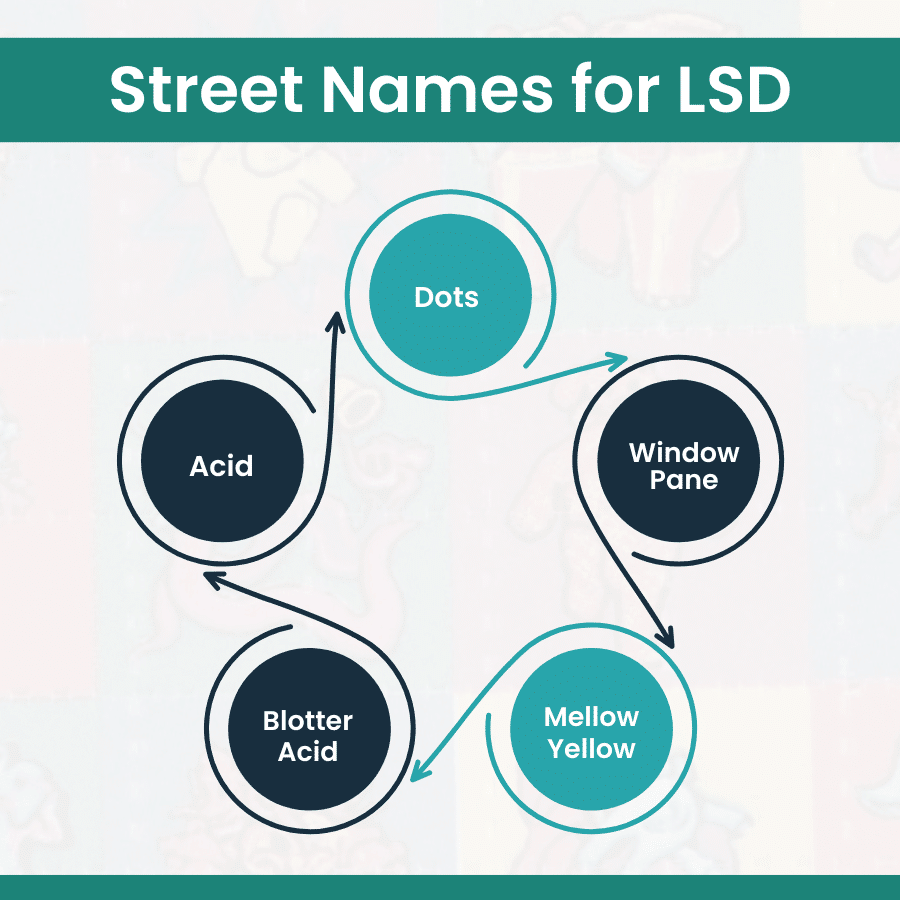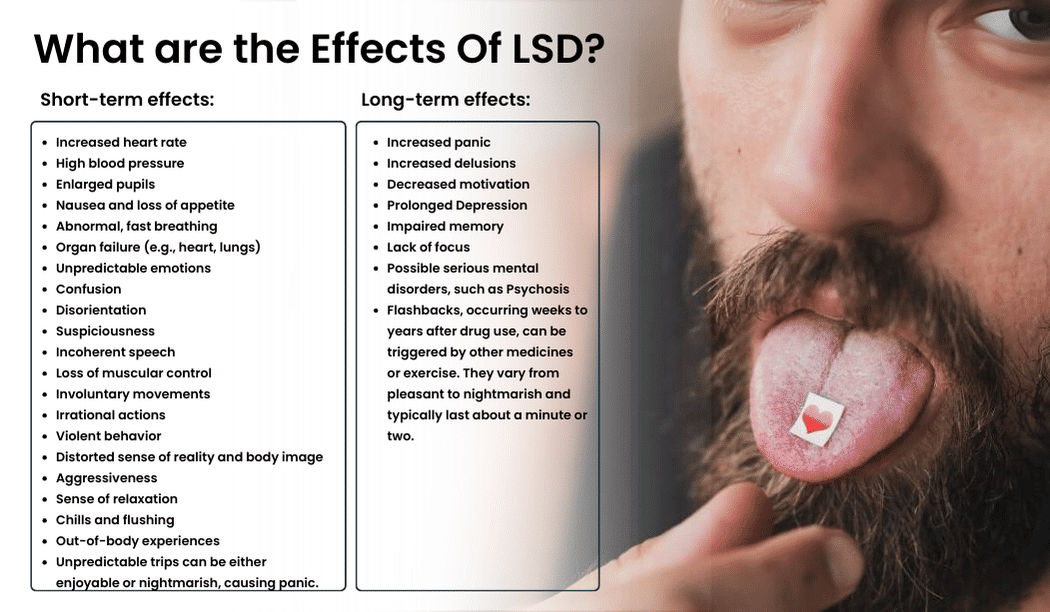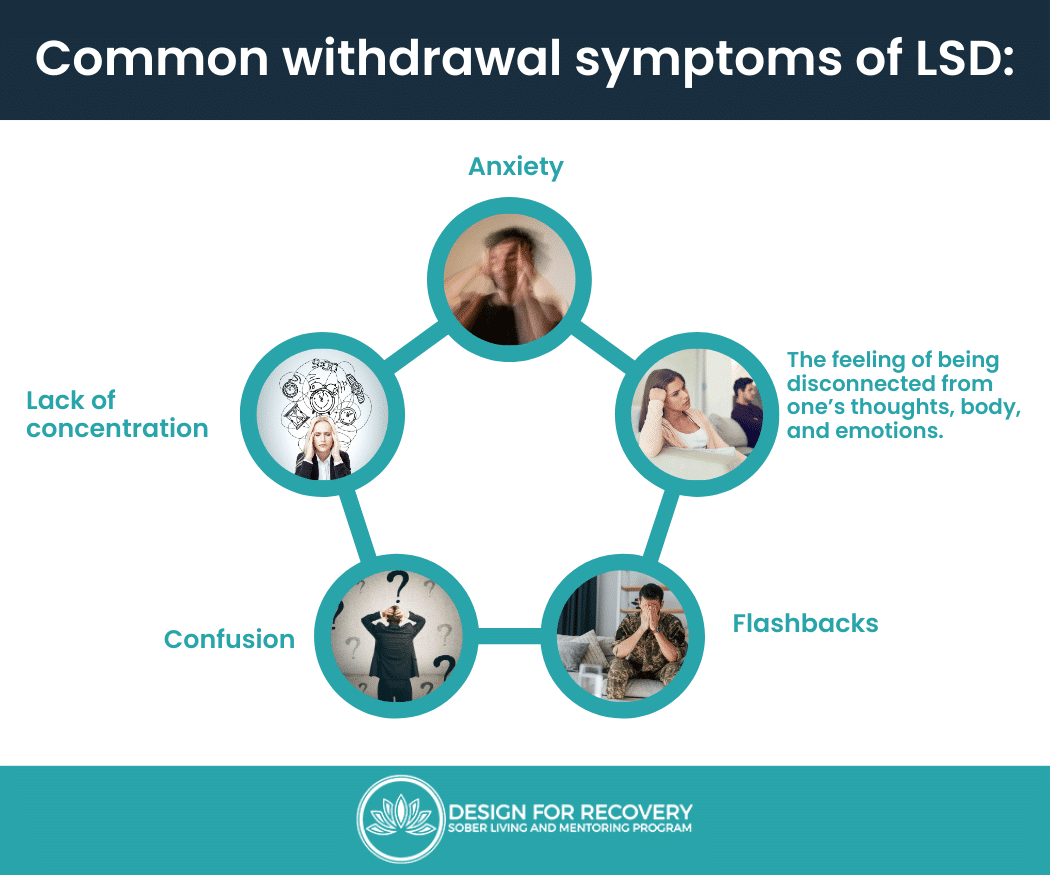LSD, or lysergic acid diethylamide, is a potent hallucinogenic drug accidentally developed by Albert Hoffman in 1938 during trials with ergots, a fungal disease of rye and other crops. The FDA does not approve it for any specific use.
The worry about LSD centers on its strong hallucinogenic effects. The individual using LSD may see, hear, and feel things that are not real. In the U.S., it’s classified as a Schedule 1 drug, which means it has a high potential for abuse and has no approved medical use.
Examining the effects of LSD on the brain and behavior is critical in developing a better understanding of its negative effects. This awareness is an important step toward substance abuse therapy and sobriety.
What Is LSD?
LSD, or lysergic acid diethylamide, stands out as one of the most powerful hallucinogens known today.
Delivered in tiny doses, typically 50-200 micrograms on blotter paper, it can warp perception, mood, and senses for 8-12 hours, creating vivid, often unpredictable experiences.
Chemical Composition and Properties of LSD
Lysergic Acid Diethylamide (LSD) is a chemical formed by mixing lysergic acid with diethylamine. It acts as a hallucinogen, affecting serotonin and dopamine in the brain. Serotonin affects our mood and sleep, while dopamine affects our sense of pleasure and satisfaction.
LSD belongs to the class of ergoline alkaloids, which are chemical substances with a unique structure. It is likewise a monocarboxylic acid amide with functional similarities to the lysergamides. Lysergamides are psychedelics that alter the perception of our brain, producing sights, sounds, and experiences that are not real.
Call Design for Recovery to Begin Your Healing Journey!
Reach out to our team to discuss sober living options and next steps toward a healthier routine.
Is LSD Addictive?
Unlike substances that hook the body physically, LSD primarily risks psychological dependence, users chasing euphoric 'trips' despite dangers.
Tolerance hits fast, often after a single use, prompting some to escalate doses for the same high, which amplifies bad trip odds and mental strain.
Medical and Recreational Uses of LSD
The United States Drug Enforcement Administration (DEA) classifies lysergic acid diethylamide as a Schedule I restricted drug. Substances in the DEA Schedule I have no currently acknowledged medical use in the United States, little established safety for use under medical supervision, and a significant potential for misuse. It’s illegal to manufacture and distribute LSD.
Street names for LSD
LSD goes by several street names, such as:
- Dots
- Acid
- Blotter Acid
- Mellow Yellow
- Window Pane

What are the Effects of LSD?
LSD is very potent and has short-term and long-term effects on the body and mind, which are the following:
Short-term effects:
- Increased heart rate
- High blood pressure
- Enlarged pupils
- Nausea and loss of appetite
- Abnormal, fast breathing
- Organ failure (e.g., heart, lungs)
- Unpredictable emotions
- Confusion
- Disorientation
- Suspiciousness
- Incoherent speech
- Loss of muscular control
- Involuntary movements
- Irrational actions
- Violent behavior
- Distorted sense of reality and body image
- Aggressiveness
- Sense of relaxation
- Chills and flushing
- Out-of-body experiences
- Unpredictable trips can be either enjoyable or nightmarish, causing panic.
Long-term effects:
- Increased panic
- Increased delusions
- Decreased motivation
- Prolonged Depression
- Impaired memory
- Lack of focus
- Possible serious mental disorders, such as Psychosis
- Flashbacks, occurring weeks to years after drug use, can be triggered by other medicines or exercise. They vary from pleasant to nightmarish and typically last about a minute or two.
LSD has significant effects on both cognitive and bodily functions. Users frequently report altered perceptions, confused thinking, and sensory perception changes. Additionally, LSD can cause alterations in motor abilities, coordination, and physical sensation. The impact is often unpredictable and varies greatly across individuals.

Contact Design for Recovery Today!
Fill out our quick form to connect with a peer mentor and learn how our sober living community supports accountability, structure, and personal growth in recovery.
LSD Overdose: Signs, Symptoms & Emergency Response
LSD overdoses are rare due to its extreme potency, a typical dose is just 50-200 micrograms, often delivered on small blotter tabs.
While fatal physical toxicity is uncommon, large doses can trigger severe psychological distress known as a 'bad trip,' causing intense anxiety, panic, paranoia, and detachment from reality.
Recognizing overdose signs early can prevent escalation. Common symptoms include:
- Physical signs: Chills, enlarged pupils, nausea/vomiting, excessive sweating, increased heart rate/blood pressure, and erratic behavior.
- Mental/emotional signs: Overwhelming hallucinations, extreme anxiety or panic, paranoia/fear of losing control, distorted sense of time/reality, impaired judgment, and disorientation.
If someone shows these symptoms or is in distress from LSD use, act quickly, time matters for their safety.
Emergency Response Steps
- Call 911 immediately: (or your local emergency number) and explain the situation clearly.
- Stay calm and stay with them: Reassure the person that help is coming.
- Create a safe space: Dim lights, reduce noise/crowds, and remove hazards to avoid worsening paranoia.
- Monitor vitals: Check breathing and pulse without interfering; encourage sips of water if they're able.
- Don't restrain: Physical force can heighten fear, let professionals handle it.
- Share details with responders: Note substance used, estimated dose, and symptoms observed.
For more on hallucinogen effects and risks, check trusted resources. In recovery, sober living homes provide ongoing support to prevent relapse and build stability.
What are the Symptoms of LSD Withdrawal?
LSD stays in the body for approximately 12 hours, and its duration of effect depends on the amount taken. After taking it by mouth, it enters your bloodstream and reaches your brain and other organs. Even though it’s in the brain for about 20 minutes, the effects last longer based on how much is in your blood. The body breaks it down within 48 hours.
Here are the common withdrawal symptoms of LSD:
- Anxiety
- Lack of concentration
- Confusion
- Flashbacks
- The feeling of being disconnected from one’s thoughts, body, and emotions.

What Are the Options for LSD Recovery and Support?
Recovery options often combine therapy, supportive environments, and healthy coping tools. These approaches help individuals address the psychological and emotional impact of LSD use, focusing on long-term sobriety and personal growth.
Common recovery approaches may include:
Therapy and Counseling
Talking with a licensed therapist can help people process difficult experiences, manage anxiety, and develop healthier habits for long-term well-being. Options like group sessions or one-on-one counseling build skills for everyday challenges.
Cognitive-Behavioral Therapy (CBT)
This goal-based approach helps participants identify unhelpful thoughts or patterns and replace them with constructive coping strategies. CBT is widely used for substance-related issues and has shown promise in reducing relapse risks.
Medication Support (if prescribed)
In some cases, medical professionals may prescribe antipsychotics, mood stabilizers, or antidepressants to manage symptoms like anxiety, mood swings, or persistent hallucinations. These are always tailored by a doctor based on individual needs and monitored closely.
Structured or Residential Programs
For individuals seeking a focused recovery environment, short-term inpatient programs can provide structure, stability, and continuous supervision in a therapeutic setting.
Outpatient Programs
These allow individuals to live at home while participating in scheduled therapy sessions. Suited for milder needs or those with work commitments, outpatient care offers flexibility but requires strong personal discipline amid daily triggers.
Sober Living Communities
After formal treatment or as part of long-term recovery, sober living homes offer a stable, substance-free setting. Residents build daily structure, accountability, and peer support through shared chores, meetings, and employment guidance while transitioning into independent life.
Each person’s path looks different, often blending these options for the best fit. The key is finding the right combination of professional guidance, supportive environments, and community accountability that encourages ongoing recovery and personal growth.
- What Is LSD?
- Chemical Composition and Properties of LSD
- Is LSD Addictive?
- Medical and Recreational Uses of LSD
- Street names for LSD
- What are the Effects of LSD?
- LSD Overdose: Signs, Symptoms & Emergency Response
- Emergency Response Steps
- What are the Symptoms of LSD Withdrawal?
- What Are the Options for LSD Recovery and Support?
Begin Lasting Sobriety Now!
Frequently Asked Questions about LSD Addiction, Abuse and Treatment
LSD’s effects typically begin within 30-60 minutes, quickly reaching the brain and spreading throughout the body. Although it leaves the brain after 20 minutes, the effects can continue for up to 12 hours due to dose-proportional pharmacology. Individual responses vary greatly, making experiences unpredictable even when using similar concentrations and doses.
LSD can cause persistent hallucinogen-induced perceptual disorder (HPPD), where individuals experience recurring visual disturbances, commonly referred to as “flashbacks.” It may last weeks or even up to years after LSD use.
LSD’s interactions with other substances can be unpredictable. Combining it with antidepressants may result in serotonin syndrome, which results in delirium and an altered mental state. Antipsychotic drugs’ effects may be reduced, affecting those with psychotic disorders. Stimulants can increase anxiety and cardiovascular risks, while benzodiazepines can lessen the intensity of an LSD trip.
The long-term mental health effects of LSD use are not fully understood. While research is ongoing, there’s limited evidence of persistent psychological damage. However, flashbacks, hallucinations, and mood disorders can linger, especially for those with existing mental health issues.
LSD distinguishes itself from other hallucinogen-induced experiences due to its rapid onset, short duration, and powerful hallucinations, which frequently involve complicated patterns and interactions.
Between 2018 and 2021, research noted a significant increase in the use of non-LSD hallucinogens among young adults (ages 19-30) in the United States. The prevalence rose from 3.4% in 2018 to 6.6% in 2021. The study shows the prevalence of use in young white adult males.
Overdosing on LSD is rare, but it can lead to psychological distress or a “bad trip.” Management involves reassurance and a calm environment. Seeking professional medical help is advisable in severe cases.
LSD is a Schedule I controlled substance, which means that possessing, distributing, or using it is forbidden under US federal law. There are exemptions for religious or research purposes, and infractions can result in fines or jail time.
Learn to live a Sober, Vibrant & Substance-Free Life
Tough days might come, but with our supportive sober community, you're never alone.
We're here to provide guidance and support for anyone on their sober living journey.
Our success stories stand testament.
Have a confidential chat with our team about admission details, house guidelines, and community support.